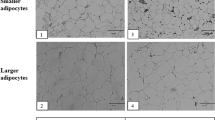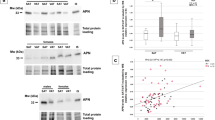Abstract
BACKGROUND:
Adipose tissue dysfunction is associated with inflammation, type 2 diabetes mellitus and vascular diseases. Visceral adipose tissue (VAT)-derived adipokines, which are released in the portal circulation may influence liver metabolism.
OBJECTIVES:
(1) To estimate the contribution of VAT and subcutaneous adipose tissue (SAT) on adipokine levels by measuring differences in adipokine concentrations between the portal draining inferior mesenteric vein and the subclavian vein. (2) To determine the relation of both VAT and SAT quantity and composition to mesenteric and systemic concentrations of adipokines.
DESIGN:
Cross-sectional cohort study.
SUBJECTS:
A total of 32 patients undergoing abdominal aortic surgery.
MEASUREMENTS:
A panel of 18 adipokines was measured in perioperatively obtained blood samples from the subclavian vein and the inferior mesenteric vein. Adipocyte size, macrophage infiltration and capillary density were measured in subcutaneous and mesenteric adipose tissue biopsies; SAT and VAT areas were measured on computed tomography images.
RESULTS:
Serum interferon-γ-inducible protein 10 (IP-10) and hepatocyte growth factor (HGF) concentrations were significantly higher in the inferior mesenteric vein vs the subclavian vein. SAT area (β –18; 95% confidence interval (CI) −35 to −2), subcutaneous adipocyte size (β –488; 95% CI −938 to −38) and SAT macrophages quantity (β –1439; 95% CI −2387 to −491) were negatively associated with adiponectin levels in the systemic circulation. SAT area was related to systemic concentrations of leptin. Mesenteric adiponectin concentrations were related to VAT area (β –20; 95% CI −35 to −5) and visceral adipocyte size (β −1076; 95% CI −1624 to −527). VAT area, adipocyte size and capillary density were related to systemic adiponectin concentrations.
CONCLUSION:
SAT and VAT quantities as well as morphologic characteristics of both adipose tissue depots are related to systemic and mesenteric adipokine concentrations. There were no differences in adipokine concentrations between the mesenteric and subclavian vein, except for higher IP-10 and HGF concentrations in the inferior mesenteric vein, indicating a possible contribution of VAT to IP-10 and HGF levels.
This is a preview of subscription content, access via your institution
Access options
Subscribe to this journal
Receive 12 print issues and online access
$259.00 per year
only $21.58 per issue
Buy this article
- Purchase on Springer Link
- Instant access to full article PDF
Prices may be subject to local taxes which are calculated during checkout

Similar content being viewed by others
References
Trayhurn P . Adipocyte biology. Obes Rev 2007; 8 (Suppl 1): 41–44.
Yusuf S, Hawken S, Ounpuu S, Bautista L, Franzosi MG, Commerford P et al. Obesity and the risk of myocardial infarction in 27 000 participants from 52 countries: a case-control study. Lancet 2005; 366: 1640–1649.
Faber DR, de Groot PG, Visseren FL . Role of adipose tissue in haemostasis, coagulation and fibrinolysis. Obes Rev 2009; 10: 554–563.
Fain JN, Madan AK, Hiler ML, Cheema P, Bahouth SW . Comparison of the release of adipokines by adipose tissue, adipose tissue matrix, and adipocytes from visceral and subcutaneous abdominal adipose tissues of obese humans. Endocrinology 2004; 145: 2273–2282.
Fontana L, Eagon JC, Trujillo ME, Scherer PE, Klein S . Visceral fat adipokine secretion is associated with systemic inflammation in obese humans. Diabetes 2007; 56: 1010–1013.
Weisberg SP, McCann D, Desai M, Rosenbaum M, Leibel RL, Ferrante Jr AW . Obesity is associated with macrophage accumulation in adipose tissue. J Clin Invest 2003; 112: 1796–1808.
Arner E, Westermark PO, Spalding KL, Britton T, Ryden M, Frisen J et al. Adipocyte turnover: relevance to human adipose tissue morphology. Diabetes 2010; 59: 105–109.
Bays HE, Gonzalez-Campoy JM, Bray GA, Kitabchi AE, Bergman DA, Schorr AB et al. Pathogenic potential of adipose tissue and metabolic consequences of adipocyte hypertrophy and increased visceral adiposity. Expert Rev Cardiovasc Ther 2008; 6: 343–368.
O’Connell J, Lynch L, Cawood TJ, Kwasnik A, Nolan N, Geoghegan J et al. The relationship of omental and subcutaneous adipocyte size to metabolic disease in severe obesity. PLoS One 2010; 5: e9997.
Veilleux A, Caron-Jobin M, Noel S, Laberge PY, Tchernof A . Visceral adipocyte hypertrophy is associated with dyslipidemia independent of body composition and fat distribution in women. Diabetes 2011; 60: 1504–1511.
Gealekman O, Guseva N, Hartigan C, Apotheker S, Gorgoglione M, Gurav K et al. Depot-specific differences and insufficient subcutaneous adipose tissue angiogenesis in human obesity. Circulation 2011; 123: 186–194.
Fox CS, Massaro JM, Hoffmann U, Pou KM, Maurovich-Horvat P, Liu CY et al. Abdominal visceral and subcutaneous adipose tissue compartments: association with metabolic risk factors in the Framingham Heart Study. Circulation 2007; 116: 39–48.
Despres JP, Lemieux I, Bergeron J, Pibarot P, Mathieu P, Larose E et al. Abdominal obesity and the metabolic syndrome: contribution to global cardiometabolic risk. Arterioscler Thromb Vasc Biol 2008; 28: 1039–1049.
Schipper HS, de JW, van Dijk ME, Meerding J, Zelissen PM, Adan RA et al. A multiplex immunoassay for human adipokine profiling. Clin Chem 2010; 56: 1320–1328.
Irlbeck T, Massaro JM, Bamberg F, O’Donnell CJ, Hoffmann U, Fox CS . Association between single-slice measurements of visceral and abdominal subcutaneous adipose tissue with volumetric measurements: the Framingham Heart Study. Int J Obes (Lond) 2010; 34: 781–787.
Faber DR, van der Graaf Y, Westerink J, Visseren FL . Increased visceral adipose tissue mass is associated with increased C-reactive protein in patients with manifest vascular diseases. Atherosclerosis 2010; 212: 274–280.
Pou KM, Massaro JM, Hoffmann U, Vasan RS, Maurovich-Horvat P, Larson MG et al. Visceral and subcutaneous adipose tissue volumes are cross-sectionally related to markers of inflammation and oxidative stress: the Framingham Heart Study. Circulation 2007; 116: 1234–1241.
Van HV, Reynisdottir S, Eriksson P, Thorne A, Hoffstedt J, Lonnqvist F et al. Leptin secretion from subcutaneous and visceral adipose tissue in women. Diabetes 1998; 47: 913–917.
Friedman JM, Halaas JL . Leptin and the regulation of body weight in mammals. Nature 1998; 395: 763–770.
Magni P, Liuzzi A, Ruscica M, Dozio E, Ferrario S, Bussi I et al. Free and bound plasma leptin in normal weight and obese men and women: relationship with body composition, resting energy expenditure, insulin-sensitivity, lipid profile and macronutrient preference. Clin Endocrinol (Oxf) 2005; 62: 189–196.
Minocci A, Savia G, Lucantoni R, Berselli ME, Tagliaferri M, Calo G et al. Leptin plasma concentrations are dependent on body fat distribution in obese patients. Int J Obes Relat Metab Disord 2000; 24: 1139–1144.
Hajer GR, van Haeften TW, Visseren FL . Adipose tissue dysfunction in obesity, diabetes, and vascular diseases. Eur Heart J 2008; 29: 2959–2971.
Arita Y, Kihara S, Ouchi N, Takahashi M, Maeda K, Miyagawa J et al. Paradoxical decrease of an adipose-specific protein, adiponectin, in obesity. Biochem Biophys Res Commun 1999; 257: 79–83.
Skurk T, berti-Huber C, Herder C, Hauner H . Relationship between adipocyte size and adipokine expression and secretion. J Clin Endocrinol Metab 2007; 92: 1023–1033.
Bruun JM, Lihn AS, Verdich C, Pedersen SB, Toubro S, Astrup A et al. Regulation of adiponectin by adipose tissue-derived cytokines: in vivo and in vitro investigations in humans. Am J Physiol Endocrinol Metab 2003; 285: E527–E533.
Trayhurn P, Wang B, Wood IS . Hypoxia in adipose tissue: a basis for the dysregulation of tissue function in obesity? Br J Nutr 2008; 100: 227–235.
Taub DD, Lloyd AR, Conlon K, Wang JM, Ortaldo JR, Harada A et al. Recombinant human interferon-inducible protein 10 is a chemoattractant for human monocytes and T lymphocytes and promotes T cell adhesion to endothelial cells. J Exp Med 1993; 177: 1809–1814.
Dufour JH, Dziejman M, Liu MT, Leung JH, Lane TE, Luster AD . IFN-gamma-inducible protein 10 (IP-10; CXCL10)-deficient mice reveal a role for IP-10 in effector T cell generation and trafficking. J Immunol 2002; 168: 3195–3204.
Herder C, Hauner H, Kempf K, Kolb H, Skurk T . Constitutive and regulated expression and secretion of interferon-gamma-inducible protein 10 (IP-10/CXCL10) in human adipocytes. Int J Obes (Lond) 2007; 31: 403–410.
Ma H, Calderon TM, Fallon JT, Berman JW . Hepatocyte growth factor is a survival factor for endothelial cells and is expressed in human atherosclerotic plaques. Atherosclerosis 2002; 164: 79–87.
Susen S, Sautiere K, Mouquet F, Cuilleret F, Chmait A, McFadden EP et al. Serum hepatocyte growth factor levels predict long-term clinical outcome after percutaneous coronary revascularization. Eur Heart J 2005; 26: 2387–2395.
Rajpathak SN, Wassertheil-Smoller S, Crandall J, Liu S, Ho GY . Hepatocyte growth factor and clinical diabetes in postmenopausal women. Diabetes Care 2010; 33: 2013–2015.
Rehman J, Considine RV, Bovenkerk JE, Li J, Slavens CA, Jones RM et al. Obesity is associated with increased levels of circulating hepatocyte growth factor. J Am Coll Cardiol 2003; 41: 1408–1413.
Bell LN, Ward JL, gawa-Yamauchi M, Bovenkerk JE, Jones R, Cacucci BM et al. Adipose tissue production of hepatocyte growth factor contributes to elevated serum HGF in obesity. Am J Physiol Endocrinol Metab 2006; 291: E843–E848.
Despres JP, Couillard C, Gagnon J, Bergeron J, Leon AS, Rao DC et al. Race, visceral adipose tissue, plasma lipids, and lipoprotein lipase activity in men and women: the Health, Risk Factors, Exercise Training, and Genetics (HERITAGE) family study. Arterioscler Thromb Vasc Biol 2000; 20: 1932–1938.
Lemieux S, Prud’homme D, Bouchard C, Tremblay A, Despres JP . Sex differences in the relation of visceral adipose tissue accumulation to total body fatness. Am J Clin Nutr 1993; 58: 463–467.
Enevoldsen LH, Simonsen L, Stallknecht B, Galbo H, Bulow J . In vivo human lipolytic activity in preperitoneal and subdivisions of subcutaneous abdominal adipose tissue. Am J Physiol Endocrinol Metab 2001; 281: E1110–E1114.
Kelley DE, Thaete FL, Troost F, Huwe T, Goodpaster BH . Subdivisions of subcutaneous abdominal adipose tissue and insulin resistance. Am J Physiol Endocrinol Metab 2000; 278: E941–E948.
Walker GE, Verti B, Marzullo P, Savia G, Mencarelli M, Zurleni F et al. Deep subcutaneous adipose tissue: a distinct abdominal adipose depot. Obesity (Silver Spring) 2007; 15: 1933–1943.
Walker GE, Marzullo P, Verti B, Guzzaloni G, Maestrini S, Zurleni F et al. Subcutaneous abdominal adipose tissue subcompartments: potential role in rosiglitazone effects. Obesity (Silver Spring) 2008; 16: 1983–1991.
Acknowledgements
This work was supported by a grant from the Leatare Foundation, Monaco and the Catharijne Foundation, The Netherlands.
Author information
Authors and Affiliations
Corresponding author
Ethics declarations
Competing interests
The authors declare no conflict of interest.
Rights and permissions
About this article
Cite this article
Faber, D., Moll, F., Vink, A. et al. Adipose tissue quantity and composition contribute to adipokine concentrations in the subclavian vein and the inferior mesenteric vein. Int J Obes 36, 1078–1085 (2012). https://doi.org/10.1038/ijo.2011.214
Received:
Revised:
Accepted:
Published:
Issue Date:
DOI: https://doi.org/10.1038/ijo.2011.214
Keywords
This article is cited by
-
Interferon-gamma released from omental adipose tissue of insulin-resistant humans alters adipocyte phenotype and impairs response to insulin and adiponectin release
International Journal of Obesity (2017)
-
Hepatocyte Growth Factor Prevented High-Fat Diet-Induced Obesity and Improved Insulin Resistance in Mice
Scientific Reports (2017)



